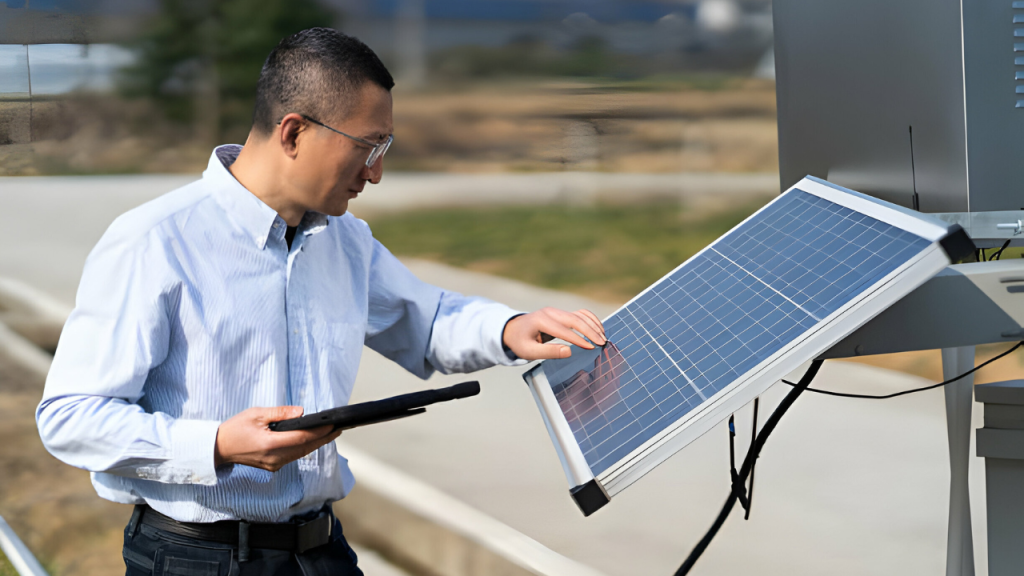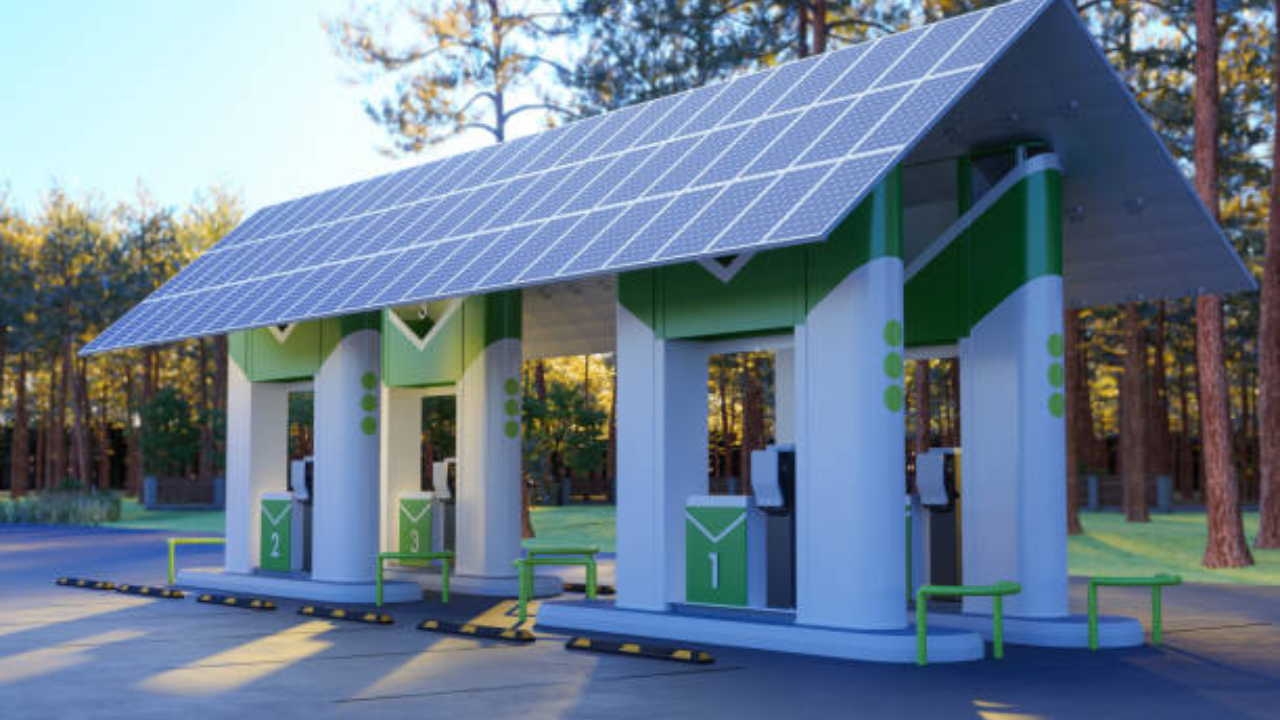You can use a multimeter to measure the voltage and current to check if solar panel is charging battery. First, connect the multimeter to the solar panel’s positive and negative terminals.
Then, check the readings to verify whether the solar panel is charging the battery. Solar panels are a sustainable and efficient means of generating electricity. They harness the power of the sun to produce electricity for various applications, including charging batteries.
However, monitoring and ensuring that the solar panel effectively charges the battery to optimize its performance is essential. Following a simple procedure using a multimeter, you can accurately determine if the solar panel is charging the battery and maintain its efficiency. We will discuss the steps to check if a solar panel is charging a battery and the significance of this process.
Determining The Charge Status
Regarding solar panels, determining the charge status is crucial for ensuring the battery is efficiently charged. You can follow a few simple steps to determine whether a solar panel effectively charges the battery. Here are some methods and techniques to help you check the charge status of a solar panel.
Checking The Charge Controller
The charge controller is the intermediary between the solar panel and the battery, regulating the charging process. To determine if the solar panel is effectively charging the battery, check the indications on the charge controller. Look for the LED indicators – green usually indicates that the battery is fully charged, orange signifies it’s in the process of charging, and red may indicate an issue that requires attention.
Monitoring The Battery Voltage
Monitoring the battery voltage is an essential method for checking the charge status of a solar panel. Measure the voltage of the battery terminals by using a voltmeter. The solar panel effectively charges the battery if the voltage is within the optimal range. Typically, a fully charged 12V battery should read between 12.6V and 13.2V, and a 24V battery should read between 25.2V and 26.4V.

Credit: www.wikihow.com
Inspecting Solar Panel Performance
Inspecting solar panel performance is essential to ensure your battery is charging efficiently. Here are effective ways to check if your solar panel is effectively charging your battery.
Inspecting Solar Panel Performance
To ensure that your solar panel effectively charges the battery, it is crucial to inspect its performance regularly. You can ensure your system operates at its best by checking the solar panel output and verifying the panel connections.
Checking the Solar Panel Output
Monitoring the voltage and current levels being generated is essential when checking the solar panel output. Use a multimeter to measure the voltage at the panel’s terminals under direct sunlight. Ideally, the voltage should match the manufacturer’s specifications for the panel.
Additionally, monitoring the current will indicate the amount of power being produced. Make sure the current output aligns with the panel’s rated capacity.
Verifying the Panel Connections
Quality connections are crucial for the proper functioning of the solar panel. Check each connection point for signs of corrosion, rust, or lose fittings. Ensure the wires are securely connected to the panel and the charge controller.
Additionally, verify that the charge controller is functioning correctly and efficiently, transferring the power to the battery while preventing overcharging.
Incorporating these routine checks into your maintenance schedule will help ensure your solar panel effectively charges the battery. Regular inspections will enable you to promptly pinpoint and address any issues, ensuring your solar power system’s longevity and optimal performance.
Monitoring Battery Charge
Regarding solar panel systems with a battery storage option, monitoring the charge level is crucial for ensuring optimal performance and avoiding potential issues. By effectively monitoring the battery charge, you can determine if the solar panel is charging the battery as expected.
Using A Battery Monitor
A battery monitor is an essential tool that allows you to keep track of the charge level of your solar panel battery. It provides real-time information about the current state of the battery, voltage, and capacity remaining. A battery monitor lets you quickly assess whether your solar panel effectively charges the battery.
Checking The Charge Level
Checking your battery’s charge level is simple and can be done using the battery monitor. Follow these steps:
- Connect the battery monitor to your solar panel battery system.
- Refer to the instruction manual to set up the monitor and ensure it is properly configured.
- Once the monitor is ready, check the display for the charge level. It typically shows the percentage of remaining charge, allowing you to determine whether the battery is charging as desired.
If the charge level on the battery monitor shows an increase from the previous reading, it indicates that your solar panel is effectively charging the battery. However, if the charge level remains the same or decreases significantly, there could be an issue with your solar panel system or battery.
Regularly monitoring the charge level of your solar panel battery is essential for maintaining its health and performance. It enables you to identify and resolve potential problems early, ensuring that your solar panel system operates optimally and your battery is charged efficiently.
Analyzing Energy Usage
Understanding power consumption and calculating energy efficiency is essential to check if a solar panel effectively charges a battery. Analyzing energy usage, we can determine whether the solar panel generates enough power to keep the battery running efficiently.
Understanding Power Consumption
Before checking if a solar panel is charging a battery, it is crucial to have a good grasp of power consumption. Power consumption is the amount of electrical energy an appliance or device uses. It is typically measured in watts (W) or kilowatts (kW) and can vary depending on the device and its use.
Understanding power consumption is essential for solar panels and batteries because it helps us gauge the energy needed to charge the battery effectively. Knowing the power consumption of the battery and the connected devices, we can ensure that the solar panel generates enough power to meet these requirements.
Calculating Energy Efficiency
Calculating energy efficiency is another crucial aspect of analyzing energy usage. Energy efficiency measures how effectively a device or system converts input energy into sound output energy. In the context of a solar panel charging a battery, it refers to how efficiently the solar panel converts sunlight into electrical energy and charges the battery.
There are various ways to calculate energy efficiency. Still, one standard method is to divide the actual output power by the input power and multiply the result by 100 to obtain a percentage. This percentage represents the energy efficiency of the solar panel and indicates how well it is performing in converting sunlight into usable energy.
Table: Calculating Energy Efficiency
| Input Power (W) | Output Power (W) | Energy Efficiency (%) |
|---|---|---|
| 100 | 80 | 80% |
| 150 | 120 | 80% |
| 200 | 160 | 80% |
In the example table above, we can see that regardless of the input power, the output power remains consistent at 80W, resulting in an energy efficiency of 80%. This indicates that the solar panel efficiently converts sunlight into electrical energy to charge the battery.
By calculating the energy efficiency of a solar panel, we can determine its effectiveness in charging a battery. A higher energy efficiency percentage indicates a more efficient and effective solar panel, ensuring the battery receives sufficient power for charging and usage.

Improving Solar Panel Efficiency
Regularly checking the battery charging status is essential to ensure optimal solar panel efficiency. Monitoring the battery charge level and voltage output regularly helps determine whether the panel is effectively charging the battery. Using a multimeter can provide accurate readings for efficient power generation.
With the increasing popularity of solar energy, more and more people are turning to solar panels to power their homes and devices. However, ensuring that your solar panel is charging the battery efficiently is essential. In this section, we will discuss two crucial factors that can help improve solar panel efficiency: cleaning the solar panels and positioning them for optimal sunlight.
Cleaning The Solar Panels
Keeping your solar panels clean is one of the simplest and most effective ways to enhance their efficiency. Dust, dirt, and debris can accumulate on the surface of your panels over time, blocking sunlight and reducing their overall performance. Regularly cleaning your solar panels will ensure they receive maximum sunlight and charge your battery efficiently.
Here are a few tips for cleaning your solar panels effectively:
- Switch off your solar panel and disconnect it from the battery before cleaning.
- Use a soft cloth or sponge and a mild detergent mixed with water to clean the panels’ surface gently.
- Avoid using abrasive materials or harsh chemicals that may damage the protective coating on the panels.
- Rinse the panels thoroughly with clean water to remove any soap residue.
- Regularly inspect your panels for any signs of damage or cracks that may affect their efficiency.
Positioning The Panels For Optimal Sunlight
The positioning of your solar panels plays a significant role in their efficiency. Placing them in an area with maximum exposure to sunlight will ensure that they generate the most electricity and charge your battery effectively. Here are a few tips for positioning your solar panels:
- Install your solar panels at an angle that allows them to receive direct sunlight for the most extended period.
- Ensure that no obstructions, such as trees, buildings, or other structures, can cast shadows on your panels.
- Regularly monitor the sun’s position throughout the day and consider adjusting the tilt or angle of your panels to maximize sunlight exposure.
- Please do not place your panels facing north, as they will receive less sunlight than those facing south.
- Consider using a solar panel tracking system that can automatically adjust the position of your panels to follow the sun’s path throughout the day.
By following these simple steps of cleaning your solar panels regularly and positioning them for optimal sunlight, you can significantly improve the efficiency of your solar panel system and ensure that your battery is charging effectively.

Credit: randomnerdtutorials.com
How do I know if my solar battery is bad?
Determining if a solar battery is bad involves assessing its performance and health. Here are some signs that may indicate a solar battery issue:
- Reduced Capacity: If your solar battery is not holding its charge as well as it used to, it may indicate a problem. Measure the actual capacity compared to the manufacturer’s specifications.
- Shorter Lifespan: Solar batteries have a finite lifespan, typically measured in cycles. If your battery is reaching the end of its expected lifespan, it may be less efficient and more prone to failure.
- Inconsistent Charging or Discharging: If you notice irregular charging or discharging patterns, such as sudden drops in voltage or capacity, it could be a sign of a malfunction.
- Overheating: Excessive heat can be damaging to batteries. If your solar battery feels unusually hot or if you observe signs of overheating, such as swelling, it could indicate a problem.
- Physical Damage: Inspect the battery for damage, leaks, or unusual bulges. Damaged batteries may not function correctly and can be hazardous.
- Error Messages or Alerts: Check the monitoring system or any provided indicators for error messages or alerts related to the battery. These can provide insights into potential issues.
- Incompatibility Issues: If you’ve recently integrated a new component or changed your solar power system, ensure the battery is compatible with the rest. Incompatibility issues can lead to performance problems.
- Testing with Battery Analyzers: Some advanced users may use battery analyzers or testers to assess the health of their solar batteries. These tools can measure parameters like voltage, current, and internal resistance.
If you suspect an issue with your solar battery, it’s recommended to contact the manufacturer or a qualified technician for further assistance. They may be able to perform more in-depth diagnostics or suggest a replacement if necessary. Regular maintenance and monitoring of your solar power system can help identify potential issues early on.
How to test a solar panel without a multimeter
While a multimeter is a commonly used tool for testing solar panels, there are alternative methods to assess the performance of a solar panel without one.
Remember that these methods may not provide precise measurements, but they can give you a general idea of whether the panel works. Here are a few options:
- Visual Inspection:
- Check for physical damage: Inspect the solar panel for visible damage, such as cracks, scratches, or water ingress. Physical damage can affect the panel’s performance.
- Look for discoloration: Dark spots or discoloration on the solar cells may indicate issues with specific cells or sections.
- Shadow Test:
- On a sunny day, place your hand or an opaque object over a small portion of the solar panel.
- Observe the other portions of the panel that are not shaded. You should notice decreased power output in the shaded area, while the unshaded areas should still generate power.
- Voltage Check (Caution: Limited Accuracy):
- Use a low-voltage DC device such as an LED or a small fan.
- Connect the device directly to the solar panel terminals.
- If the panel is generating power, the device should operate.
- Solar-Powered Device:
- Connect a solar-powered device (such as a solar garden light) to the solar panel.
- If the device operates or the light turns on when exposed to sunlight, it indicates that the panel is generating power.
- Compare with Another Panel:
- If you have multiple solar panels, compare the output of the suspected panel with a known working panel under similar conditions.
- A significant difference in output may indicate an issue with the panel in question.
Remember that these methods are essential and may not provide accurate quantitative data about the solar panel’s performance. Using a multimeter or consulting a professional technician would be advisable for a more detailed analysis, especially if you suspect a malfunction.
Multimeters are relatively inexpensive and widely available, making them a valuable tool for assessing solar panels accurately.
Frequently Asked Questions For How To Check If Solar Panel Is Charging Battery
How Do I Know If My Solar Panel Is Charging My Battery?
You can use a multimeter to measure the voltage at the battery terminals to check if your solar panel is charging your battery. If the voltage reading exceeds the battery’s current charge, the solar panel is charging the battery.
What Should The Voltage Be On A Charging Solar Panel Battery?
The voltage on a charging solar panel battery should be higher than the current charge of the battery. This ensures the solar panel supplies enough power to charge the battery effectively. A voltage reading below the battery’s current charge indicates a problem with the charging process.
Can A Solar Panel Charge A 12v Battery?
Yes, a solar panel can charge a 12V battery. However, ensuring that the solar panel’s voltage output matches the battery’s voltage requirements is essential. A charge controller is also recommended to regulate the charging process and prevent overcharging the battery.
How Long Does It Take To Charge A Battery With A Solar Panel?
The charging time of a battery with a solar panel depends on various factors, such as the panel size, the amount of sunlight available, and the battery’s capacity. On average, it can take anywhere from a few hours to a day to fully charge a battery using a solar panel.
How can I tell if my solar panels are charging my battery?
Check the charge controller or inverter display for information on current battery charge levels or incoming solar power. Additionally, you can use a multimeter to measure the voltage at the battery terminals – an increase indicates charging. Observe any LED indicators on the charge controller, which typically show the charging status.
How do you test a solar panel for charging?
Use a multimeter set to measure DC voltage. Connect the multimeter leads to the solar panel terminals – positive to positive, negative to negative. A reading above the panel’s rated voltage indicates it is generating power and charging in sunlight.
How do you know if the solar panels are working?
Check the inverter or charge controller display for power production information. Look for LED indicators showing system status. Monitor your energy production against expected values. Use a solar panel tester or a multimeter to measure voltage output in sunlight.
Why is my solar not charging my battery?
Possible reasons:
- Insufficient sunlight or shading.
- Faulty solar panel, charge controller, or inverter.
- Poor connections or wiring issues.
- Inadequate battery capacity or a defective battery.
- Malfunctioning charge controller preventing proper charging.
Do solar panels stop charging when battery is full?
Yes, an adequately configured solar power system with a charge controller will typically stop charging the battery once it reaches total capacity to prevent overcharging and potential damage.
Conclusion
To determine if your solar panel is effectively charging your battery, it’s crucial to employ the correct methods and equipment. You can ensure the process functions optimally by using a multimeter, monitoring voltage levels, and examining the charge controller.
Remember to regularly clean and maintain your solar panels, significantly impacting their efficiency. Embrace these guidelines and maximize the potential of your solar panel system for long-lasting battery charging.

I am a Mahdi . I have four two of experience in Technology and all types of Battery’s like Solar Battery, Car Battery, Lithium Battery etc. So I work on solving these issues and give various tips on these issues.
